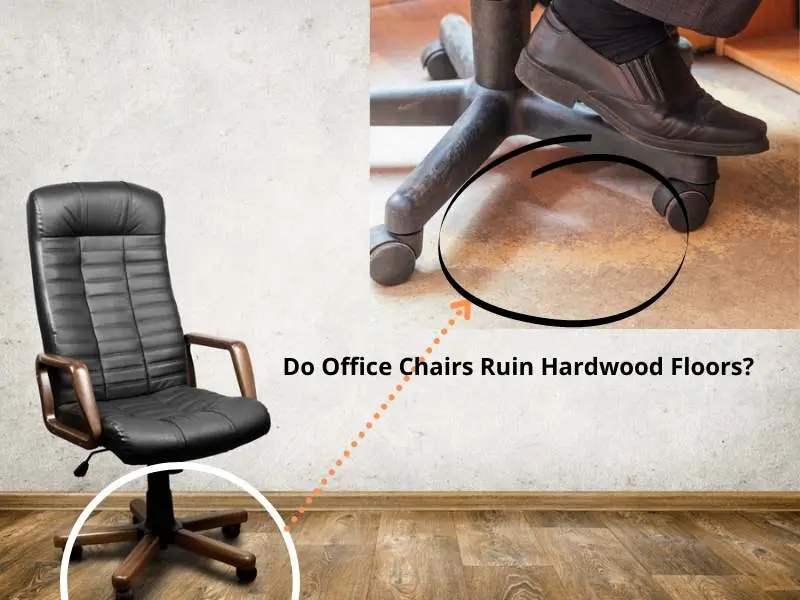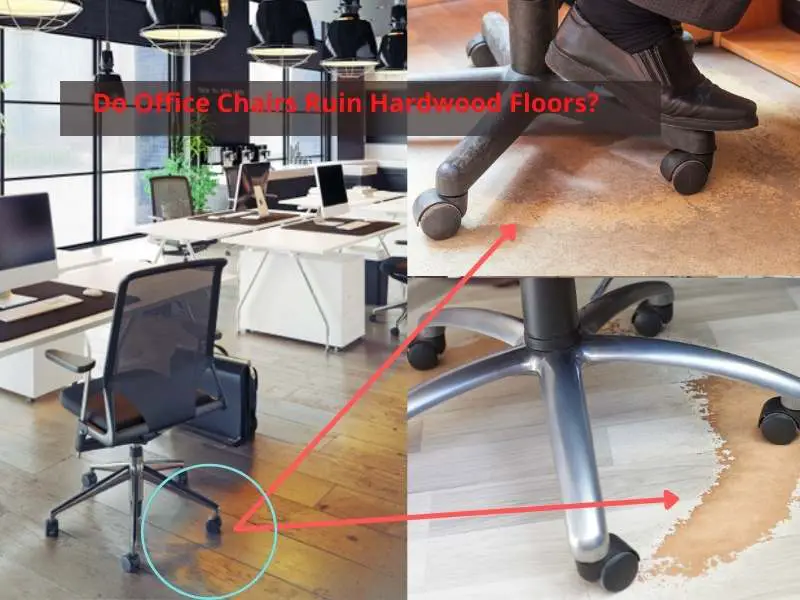Rolling office chairs are great for maneuverability and offer excellent lumbar support, while wheel-less ones are more practicable for limited office spaces like in a home office.
Both rolling and wheel-less types of office chairs can cause scuff marks on your hardwood floor. It’s easier and more economical to prevent office chair damage on hardwood floors instead of waiting to replace the worn-out hardwood planks.
Can I use an office chair on hardwood?
You can safely use an office chair on hardwood flooring, provided you take the necessary measures to protect the floor surface. Without these floor protection measures, the casters/wheels of your rolling office chair will eventually leave ugly scuff marks on your hardwood surface.

This kind of hardwood floor damage is more likely if the office chair casters are made of hardy material, due to the faster rate of surface wear and tear. Scuff marks caused by rolling office chairs are also more noticeable on softer hardwoods like maple and oak than they are on harder woods like mahogany and hickory.
Is office chair safe for hardwood floors?
Office chairs can reduce the lifespan of your hardwood floor, as the back and forth rolling of the wheels gradually cause wear. And that’s not all: the hardwood surface slowly assumes an unsightly appearance that’s reminiscent of an old cutting board.
While the office chair casters are directly responsible for most of the damage due to how hard most of them are, hardwood floor scuff marks may also be caused by debris and dirt particles stuck to the casters. As the hard casters glide and press the debris against the hardwood floor, the particles scratch the floor surface.
Do Office Chairs Ruin Hardwood Floors?
Rolling office chairs can ruin hardwood floors, depending on the frequency of use. If you spend a lot of time in your home office, you’re likely rolling back and forth around the same area in front of your desk. The hardwood floor planks in this part of the room will eventually spot deep scratch marks and will need to be replaced.

Do chairs scratch hardwood floors?
Due to the constant swiveling, rolling office chairs are more likely to leave marks on hardwood compared to normal chairs that lack wheels. You’re more likely to leave behind deeper and more prominent scuff marks on your hardwood floorboards compared to those caused by a caster-free office chair that’s mostly stationary. Nevertheless, both of these types of chairs have the potential to cause wear and tear on hardwood flooring.
How to protect hardwood floor from office chair+ wheels
Some of the best options include installing soft casters, installing an area rug, installing a chair mat, using furniture pads, and regularly cleaning the hardwood floor and chair casters as well. Other less common but effective solutions include covering the office chair wheels with duct tape or soft clothing.
Use Soft Casters
Most office chairs have wheels made of hardy materials like plastic and hard nylon. If your office chair has such hard casters, consider replacing them with softer alternatives made of materials like rubber, neoprene, or urethane. To properly replace your casters, carefully follow the manufacturer’s guidelines.
Install an Area Rug
Installing an area rug under your rolling office chair keeps the chair from coming into direct contact with the hardwood floor, thus preventing scuff marks. The area rug should be large enough to cover the entire home office area that you often find yourself moving in. Also, woven mats/area rugs are preferable, as they offer the utmost protection.
Note: Area rugs not only serve as a hardwood floor protection material but also as floor décor. You can choose from several different designs and colors for this aesthetic purpose.
Install an Office Chair Mat
Office chair mats are a great alternative to area rugs. The latter works great but can bend in certain places at times, causing your chair to get stuck as you try to roll over from one workplace position to another. By contrast, office chair mats typically feature teeth-like fittings on the bottom side to securely attach to hardwood flooring or carpets, thus being less likely to lift in certain spots.
Cover the Wheels with Tape
If you find caster replacement to be too laborious of a task, you can opt to cover up the casters with duct tape. Alternatively, you can use soft clothing. Doing so helps to soften the impact that the hard casters have on the hardwood floor.
Note: Though both of these options ensure your chair casters don’t swivel and scrape your wooden floor planks, they’re more of short-term fixes, as they wear out rather fast. However, if you’re working on a budget, these economical options are an easy way to protect your hardwood floor from rolling office chairs.
Install Furniture Pads
The term ‘furniture pads’ refers to a variety of protective covers that are designed to attach to furniture legs and this prevents floor surfaces from furniture impact damage. They’re typically made of soft materials like cork or rubber to soften the kind of impact that causes scuff marks on hardwood floors when you move an office chair over the flooring.
Common types of furniture pads that you can attach to your office chair legs include adhesive pads, nail-on pads, slip-on pads, and cardboard pads. Despite there being a few differences between these types of furniture pads, their ease of replacement/installation remains the common factor.
Note: Most furniture pads are designed to be used on chairs with normal legs, not rolling chairs. Thus, most of the options in this section apply to office chairs with no casters.
- Adhesive Pads
Adhesive pads are a more durable but costlier alternative to duct tape. One end of the pads sticks to the bottom of the office chair legs, while the end that comes into contact with the hardwood floor is made of rubber for a softer impact.
Beware, though, that while adhesive pads last longer than duct tape or soft clothing, they’re not a permanent solution. The pads gradually lose their bonding power and will come out with time.
2. Nail-on Pads
Nail-on pads are a more permanent alternative to duct tape, soft clothing, and even adhesive pads; as nails and screws securely attach the pads to the office chair legs. Take note, though, that they’re a bit more difficult to install compared to other types of furniture pads.
3. Slip-on Pads
Slip-on pads last longer than adhesive pads but aren’t as permanent as nail-on pads. And they’re the easiest to install, as you simply glide them into position under the chair legs. This is a great option if you have an office chair with no casters.
4. Cardboard Pads
Cardboard pads are a homemade solution whereby you cut out cardboard pieces and affix/glue them to the bottom of your office chair legs. The cardboard material is usually thick enough to protect hardwood surfaces from scuff marks for a decent amount of time.
Keep the wheels and floor Clean
As earlier mentioned, debris usually sticks to office chair casters, enhancing the potential for hardwood floor damage. To prevent the casters from ferrying dirt particles and debris across the wooden floor surface, ensure you regularly clean the wheels.
Also, ensure the hardwood floor itself is regularly cleaned of dust, dirt, and debris. With no dirt particles being carried across the room, there’s a lower likelihood of hardwood floor damage caused by the debris.
Here is a video on how to protect your hardwood floor from office chair damage:
Source and References
- Wikipedia: https://en.wikipedia.org/wiki/Office_chair
